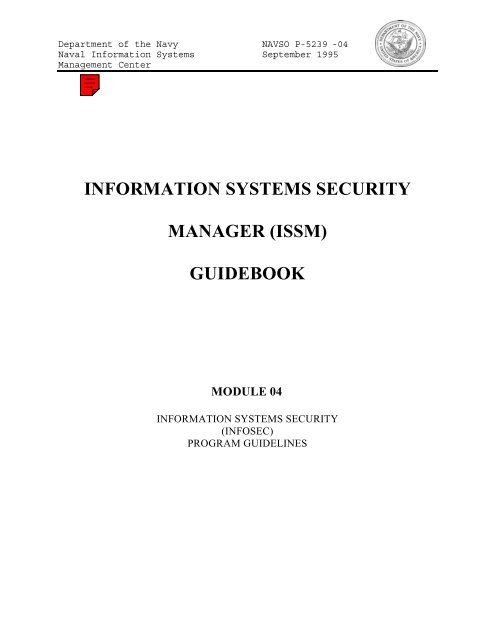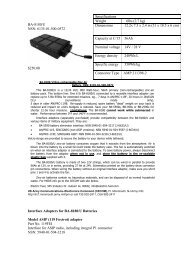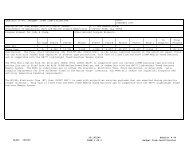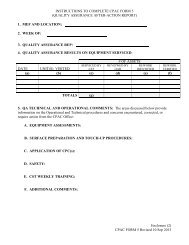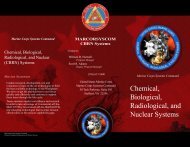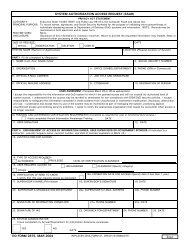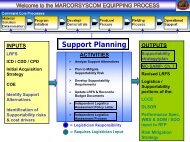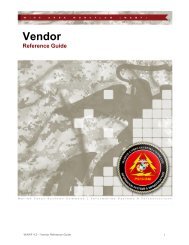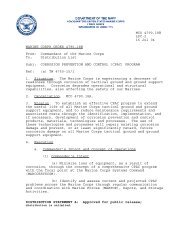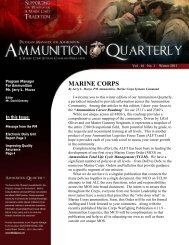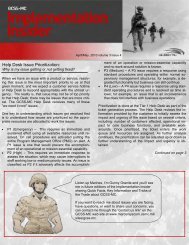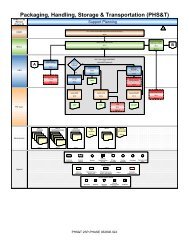Information Systems Security Manager (ISSM) - Marine Corps ...
Information Systems Security Manager (ISSM) - Marine Corps ...
Information Systems Security Manager (ISSM) - Marine Corps ...
Create successful ePaper yourself
Turn your PDF publications into a flip-book with our unique Google optimized e-Paper software.
Department of the Navy NAVSO P-5239 -04Naval <strong>Information</strong> <strong>Systems</strong> September 1995Management CenterINFORMATION SYSTEMS SECURITYMANAGER (<strong>ISSM</strong>)GUIDEBOOKMODULE 04INFORMATION SYSTEMS SECURITY(INFOSEC)PROGRAM GUIDELINES
NAVSO P-5239-04SEPTEMBER 1995Distribution: Submit requests for placement on distribution (including supporting justification), oramendment to the existing distribution, to:Commanding OfficerNaval Command, Control and Ocean Surveillance CenterISE East Coast DivisionCode 423400 Marriott DriveNorth Charleston, SC 29406-6504Commercial (803) 974-6756DSN 563-2030, extension 6756E-Mail: subscribe@infosec.nosc.milElectronic versions of this document may be downloaded via anonymous ftp frominfosec.nosc.mil or //http://infosec.nosc.mil/inf.html.Stocked:Additional copies of NAVSO P-5239-04 can be obtained from the Navy Aviation SupplyOffice (Code 1013), 5801 Tabor Avenue, Philadelphia PA 19120-5099, through normalsupply channels in accordance with NAVSUP P-600 (CD-ROM only), using AUTODIN,DAMES, or MILSTRIP message format to DAAS, Dayton, OH.Cite stock number 0515-LP-208-8215.Local reproduction is authorized.
NAVSO P-5239-04SEPTEMBER 1995FOREWORDThe Navy Staff Office Publication (NAVSO P) 5239, <strong>Information</strong> <strong>Systems</strong> <strong>Security</strong>(INFOSEC) Program Guidelines is issued by the Naval <strong>Information</strong> <strong>Systems</strong> ManagementCenter. It consists of a series of modules that provide procedure, technical, administrative,and supplemental guidance for all information systems, whether business or tactical. Itapplies to information systems used in the automated acquisition, storage, manipulation,management, movement, control, display, switching, interchange, transmission, or receipt ofdata. Each module focuses on a distinct program element and describes a standardmethodology for planning, implementing, and executing that element of the INFOSECprogram within the Department of the Navy (DON).This module, the <strong>Information</strong> <strong>Systems</strong> <strong>Security</strong> <strong>Manager</strong> (<strong>ISSM</strong>) Guidebook, describesthe roles and responsibilities of the <strong>ISSM</strong> within the DON INFOSEC program.Terminology associated with information systems in general, and INFOSECspecifically, varies from service to service and from Command to Command. The AutomatedData Processing <strong>Security</strong> Officer (ADPSO) from a decade ago is now referred to as an <strong>ISSM</strong>.Section 2 discusses common DON terms for INFOSEC roles.Organizational differences make it difficult to precisely define discrete roles andresponsibilities, because organizations may choose to implement the <strong>ISSM</strong> responsibilitiesdefined in this guidebook differently. For example, the location and size of the activity orCommand, and the complexity of the ISs and networks may dictate how the role of the <strong>ISSM</strong>is implemented. In large Commands the security responsibilities defined here may be dividedamong numerous security personnel. Some Commands may have a single individualperforming all the functions identified. Regardless of the implementation, the guidebookaddresses the broadest set of functions identified for the <strong>ISSM</strong> position.During the preparation of this guidebook, several activities were contacted andinterviewed for technical inputs. The security personnel of the Commander-in-Chief, U.S.Atlantic Fleet (CINCLANTFLT), the Space and Naval Warfare <strong>Systems</strong> Command(SPAWAR), and the Naval Sea <strong>Systems</strong> Command Automated Data System Activity(SEAADSA) were extremely helpful in providing information and guidance.ii
NAVSO P-5239-04SEPTEMBER 1995TABLE OF CONTENTS1.0 INTRODUCTION ................................ ................................ ................................ .............. 1Purpose.................................................................................................................................................... 1Policy and Guidance ............................................................................................................................... 1Document Structure................................................................................................................................. 12.0 INFORMATION SYSTEMS SECURITY MANAGER ROLE ................................ ..... 3The <strong>ISSM</strong> Role........................................................................................................................................ 3Qualifications/ Prerequisites .................................................................................................................... 3Relationships ........................................................................................................................................... 43.0 INFORMATION SYSTEMS SECURITY MANAGER RESPONSIBILITIES .......... 83.1 <strong>Security</strong> Management ......................................................................................................8SECURITY POLICY AND PROCEDURES DEVELOPMENT AND APPLICATION ..8Responsibility ......................................................................................................................................... 8Implementation ....................................................................................................................................... 8Policy and Procedures Application ..................................................................................................... 8Key Document Development .............................................................................................................. 8Guidance............................................................................................................................................. 9INTERACTION WITH PERSONNEL .............................................................................. 9Responsibility ......................................................................................................................................... 9Implementation ....................................................................................................................................... 9<strong>Information</strong> <strong>Systems</strong> <strong>Security</strong> Officer and Network <strong>Security</strong> Officer Appointment ........................... 9INFOSEC Personnel Oversight ........................................................................................................ 10Coordination With Other <strong>Security</strong> Personnel ................................................................................... 10Liaison with Multi-Service Program Officials/ Functional Program Leads ...................................... 11Liaison With System and Network Administrator(s) ........................................................................ 11Maintain Currency With <strong>Security</strong> Services ....................................................................................... 113.2 Risk Management Program............................................................................................ 14Responsibility ....................................................................................................................................... 14Implementation ..................................................................................................................................... 14Risk Assessment ............................................................................................................................... 14Countermeasure Identification and Implementation ......................................................................... 15<strong>Security</strong> Test and Evaluation ............................................................................................................ 15IS Modifications ............................................................................................................................... 163.3 Accreditation.................................................................................................................. 18Responsibility ....................................................................................................................................... 18Implementation ..................................................................................................................................... 183.4 Administrative Functions ............................................................................................... 20Responsibility ....................................................................................................................................... 20Implementation ..................................................................................................................................... 20Accounts Administration Oversight ................................................................................................. 20IS Media Administration Oversight .................................................................................................. 21Virus Control and Reporting Program Oversight ............................................................................. 22<strong>Security</strong> “Watchdog” Oversight ....................................................................................................... 223.5 Training and Awareness ................................................................................................ 24Responsibility ....................................................................................................................................... 24Implementation ..................................................................................................................................... 24INFOSEC Personnel Training .......................................................................................................... 24IS User <strong>Security</strong> Training ................................................................................................................. 25iii
NAVSO P-5239-04SEPTEMBER 1995TABLE OF CONTENTS<strong>Security</strong> Awareness........................................................................................................................... 263.6 Physical <strong>Security</strong>............................................................................................................ 28Responsibility ....................................................................................................................................... 28Implementation ..................................................................................................................................... 28Facility Access.................................................................................................................................. 28User Identification and Authentication ............................................................................................. 29Data Access ...................................................................................................................................... 29Environmental Hazards Protection ................................................................................................... 29TEMPEST ........................................................................................................................................ 303.7 Auditing ......................................................................................................................... 32Responsibility ....................................................................................................................................... 32Implementation ..................................................................................................................................... 32Audit Procedures .............................................................................................................................. 32Audit Trail ........................................................................................................................................ 323.8 Incident and Violations Reporting ................................................................................. 34Responsibility ....................................................................................................................................... 34Implementation ..................................................................................................................................... 34Incident Reporting Mechanism ......................................................................................................... 34Incident Analysis .............................................................................................................................. 35<strong>Security</strong> Vulnerabilities and Problems .............................................................................................. 353.9 <strong>Security</strong> Configuration Management ............................................................................. 36Responsibility ....................................................................................................................................... 36Implementation ..................................................................................................................................... 363.10 Contingency Planning ..................................................................................................38Responsibility ....................................................................................................................................... 38Implementation ..................................................................................................................................... 383.11 <strong>Security</strong> Documentation............................................................................................... 40Activity INFOSEC Plan (ISSP) ............................................................................................................. 40System <strong>Security</strong> Plan............................................................................................................................. 40Risk Assessment ................................................................................................................................... 41ST&E Documentation ........................................................................................................................... 41Activity Accreditation Schedule (AAS) ................................................................................................ 43IS Incident Report ................................................................................................................................. 43Authorized User List ............................................................................................................................. 43<strong>Security</strong> Operating Procedures .............................................................................................................. 43Training and Awareness Documentation ............................................................................................... 43Contingency Plan .................................................................................................................................. 44APPENDIX -- <strong>Security</strong> Policy, Procedure, and Guidance DocumentationA-1iv
NAVSO P-5239-04SEPTEMBER 1995INFORMATION SYSTEM S SECURITY MANAGER (<strong>ISSM</strong>)GUIDEBOOK1.0 INTRODUCTIONTechnological progress and growth in information systems (IS) has accelerated theexpansion of information transfer, processing, and storage capabilities worldwide.Technological advances have also increased the risks associated with exploitation by bothaccidental exposure and malicious threat agents. <strong>Information</strong> <strong>Systems</strong> <strong>Security</strong> (INFOSEC) isthe discipline that provides an integrated and systematic approach to the security of all aspectsof ISs. In implementing INFOSEC, the Department of the Navy (DON) has developedseveral policy and procedures documents to increase personnel ’s understanding andawareness of INFOSEC requirements among IS sponsors, developers, and users, and toreduce risk in ISs to acceptable levels. Navy Staff Office Publication- ( NAVSO P) 5239-01,Introduction to <strong>Information</strong> <strong>Systems</strong> <strong>Security</strong>, further explains the implementation ofINFOSEC. Definitions of terms used within this document are provided in NAVSO P-5239-02, Terms, Abbreviations, and Acronyms.PurposeThis guidebook is a module within the NAVSO P -5239 series.This series is developed to assist in planning and operating ISsand to help system users maintain security awareness. Thisguidebook provides guidance and direction to current, new, andprospective <strong>ISSM</strong>s in implementing and managing overallINFOSEC programs. Specifically, it describes theresponsibilities of the <strong>ISSM</strong> and provides instruction forimplementing these responsibilities.Policy andGuidanceModule NAVSO P-5239-04 was developed in accordance withDepartment of Defense (DOD) and DON policy. Appendix Aprovides a bibliography of security policy , procedure, andguidance documentation.DocumentStructureSection 2 briefly describes the <strong>ISSM</strong>’s role, qualifications,prerequisites, and working relationships. Section 3 describes the<strong>ISSM</strong>’s responsibilities, which are organized in 11 task areas.The first task area, <strong>Security</strong> Management, can be considered anumbrella under which the remaining 10 task areas reside.Specifically, the performance or conduct of the other 10 taskareas is planned, coordinated, and facilitated under this overallmanagement function. The 11 tasks areas are as follows:1
NAVSO P-5239-04SEPTEMBER 1995· <strong>Security</strong> management· Risk management program· Accreditation· Administrative functions· Training and awareness· Physical security· Auditing· Incident and violations reporting· <strong>Security</strong> configuration management· Contingency planning· <strong>Security</strong> documentation.2
NAVSO P-5239-04SEPTEMBER 19952.0 INFORMATION SYSTEMS SECURITY MANAGER ROLEThe <strong>ISSM</strong> functions as the activity’s focal point and principal advisor for INFOSECmatters on behalf of the Designated Approving Authority ( DAA). The <strong>ISSM</strong> reports to theDAA and implements the overall INFOSEC program approved by the DAA. An activity mayhave multiple <strong>ISSM</strong>s. For example, an activity having several subordinate Command’s mayhave an <strong>ISSM</strong> assigned for each subordinate Command.The <strong>ISSM</strong> RoleIn executing the responsibilities of the position, the <strong>ISSM</strong>:· Ensures that INFOSEC program requirements are met· Implements the risk management program required bythe DON· Verifies that appropriate security tests are conducted anddocumented· Ensures that the accreditation support documentation isdeveloped and maintained· Provides the DAA with accreditation packages forsystems under the DAA’s purview to verify that each ISmeets security specifications for an acceptable level ofrisk· Reviews the accreditation plan and reaccreditationactivities· Ensures that proposed system changes are reviewed, andthat implemented system modifications do not adverselyimpact the security of the system· Ensures contingency plans are developed and tested· Ensures that IS users’ activities are monitored to verifycompliance with security policies and procedures· Coordinates regularly with <strong>Information</strong> <strong>Systems</strong><strong>Security</strong> Officers (ISSO) and Network <strong>Security</strong> Officers(NSO), who provide system-level INFOSEC supportwithin the confines of the <strong>ISSM</strong>’s area of responsibility· Maintains an Activity INFOSEC Plan (ISSP) andensures the development of System <strong>Security</strong> Plans (SSP)for systems that contain sensitive information.Qualifications/PrerequisitesNo specific formal degree program is required for the <strong>ISSM</strong>role. However, extensive experience in INFOSEC is requiredand a technical background in computer science, mathematics,engineering, or a related field is extremely beneficial. This3
NAVSO P-5239-04SEPTEMBER 1995technical background must be balanced with effectivemanagement skills, because the <strong>ISSM</strong> must interact with peopleat all levels of the organization.The <strong>ISSM</strong>’s security education and work experience shouldprovide familiarity with all aspects of INFOSEC , frompersonnel security to emanations security . <strong>Security</strong> trainingshould include DOD and DON security courses (e.g., NavyAutomated Data Processing <strong>Security</strong> Officer [ ADPSO] Course,Introduction to Computer <strong>Security</strong> or equivalent courses ). The<strong>ISSM</strong> should be familiar, through work experience, with theISSO and NSO roles and responsibilities.RelationshipsIn executing security responsibilities, the <strong>ISSM</strong> interacts withactivities and personnel within and external to the site securityorganization. This section defines the roles of the activities andpersonnel as related to INFOSEC that directly interface with the<strong>ISSM</strong>. Some of the positions described below may not exist inall Commands. Specifically, the assignment of positions isdependent on the Command structure and is at the discretion ofthe DAA.Personnel/ActivityINFOSEC RoleDAANSMThe DAA is responsible for ensuringcompliance with the DON INFOSEC Programfor the activities and ISs under the DAA’sjurisdiction. The DAA grants interim and finalapproval to operate an IS in a specific securitymode based on a review of the accreditationdocumentation and a confirmation that theresidual risk is within acceptable limits.The Network <strong>Security</strong> <strong>Manager</strong> (NSM) acts asthe focal point and principal advisor fornetwork security matters. Depending on thesize of the activity, the geographicaldistribution, and the complexity of the site, thisrole may be performed by the <strong>ISSM</strong>.4
NAVSO P-5239-04SEPTEMBER 1995ISSONSOOther Site<strong>Security</strong>PersonnelPMThe ISSO acts on behalf of the <strong>ISSM</strong> to ensurecompliance with the INFOSEC procedures atthe operational site or facility. The <strong>ISSM</strong> isresponsible for performing those dutiesnormally performed by ISSOs in the event thatno ISSOs are appointed at the particularCommand.The NSO acts on behalf of the NSM or <strong>ISSM</strong>to implement the network security policy of theactivity across all data networks at the activityunder the NSO’s authority. The <strong>ISSM</strong> isresponsible for performing those dutiesnormally performed by NSOs in the event thatno NSOs are appointed at the particularCommand.Other security-related billets are filleddepending on the structure and size of theCommand or Activity. A Site <strong>Security</strong><strong>Manager</strong> is the principal advisor oninformation and personnel security in theCommand and is responsible to theCommanding Officer for the management ofthe overall security program. Physical andPersonnel <strong>Security</strong> Officers may also bedesignated. The <strong>ISSM</strong> is responsible to theSite <strong>Security</strong> <strong>Manager</strong> for the protection ofclassified information being processed on ISs.The <strong>ISSM</strong> coordinates with other securitypersonnel to ensure the consistentimplementation of security policies andprocedures.The INFOSEC Program <strong>Manager</strong> (PM) isresponsible for the development of a systemand must be aware of the INFOSECrequirements that must be met by the specificsystem. After the system is fielded, the PMreceives inputs on the system’s operation. ThePM manages the security upgrades required forthe system through the In-Service EngineeringActivity (ISEA) and Software Support Activity(SSA).5
NAVSO P-5239-04SEPTEMBER 1995ISEASSASystem orNetworkAdministratorUserThe ISEA is responsible for implementinghardware (and total system) changes to thesystem and must coordinate with the <strong>ISSM</strong> toensure compliance with INFOSEC policies.The SSA is responsible for implementingsoftware-related changes to the system, andmust coordinate these changes with the <strong>ISSM</strong>to ensure no negative effect on the securityposture of the IS results from a change.The System or Network Administrator isresponsible for the administration andoperation of an IS and ensures the IS operatesin accordance with Command security policiesand procedures. The System or Networkadministrator also implements changes to anIS, such as software upgrades, which aredirected, in many cases, by the SSA or ISEA.In this document, the term “user” refers to allpersonnel who access the IS for authorizedpurposes and in accordance with securityprocedures and guidelines (i.e., users,operators, and maintainers). The <strong>ISSM</strong> ensuresthat the IS users are aware of their securityresponsibilities and are trained in the usersecurity features of the IS.Figure 1 illustrates the relationship of the <strong>ISSM</strong> to the security roles and titles within andexternal to the site INFOSEC organization.6
NAVSO P-5239-04SEPTEMBER 1995Figure 1<strong>ISSM</strong> Internal and External Relationships7
NAVSO P-5239-04SEPTEMBER 19953.0 INFORMATION SYSTEMS SECURITY MANAGERRESPONSIBILITIESThe <strong>ISSM</strong> is responsible for ensuring that the INFOSEC Program requirements aremet. The <strong>ISSM</strong> accomplishes this by performing, directing, coordinating, administering, andoverseeing various activities and personnel. This section defines the responsibilities of the<strong>ISSM</strong> in 11 task areas.3.1 <strong>Security</strong> ManagementThis section describes the responsibilities of the <strong>ISSM</strong> within the overall task area ofsecurity management, which is the umbrella covering the other 10 task areas. It specificallyfocuses on planning and coordinating tasks required for an effective INFOSEC program.SECURITY POLICY AND PROCEDURES DEVELOPMENT ANDAPPLICATIONResponsibilityThe <strong>ISSM</strong> is responsible for interpreting and tailoring DOD andDON security policy to meet the requirements of the Commandor activity and ISs and networks under the <strong>ISSM</strong>’s cognizance.ImplementationPolicy and ProceduresApplicationThe <strong>ISSM</strong> remains current with all DOD and DON INFOSECpolicies and procedures and is aware of changes to thesepolicies and procedures. The <strong>ISSM</strong> ensures that all INFOSECactivity within the respective Command is in accordance withDOD and DON policy and procedures. The <strong>ISSM</strong> tailors thispolicy and guidance to meet the specific Command’srequirements.Key DocumentDevelopmentThe <strong>ISSM</strong> ensures that activity-level INFOSEC policy andguidelines are documented in an Activity ISSP in accordancewith OPNAVINST 5239.1A.The <strong>ISSM</strong> also ensures the development of SSPs for each ISthat contains or processes sensitive information in accordancewith OMB Bulletin No. 90-08.8
NAVSO P-5239-04SEPTEMBER 1995GuidanceThe <strong>ISSM</strong> provides guidance to subordinate INFOSECpersonnel, IS users, and other personnel, as necessary, in theinterpretation and implementation of the Command’s INFOSECpolicies and procedures.Reference: <strong>Security</strong> policy, procedure, and guidancedocumentation is identified in Appendix A. Appendix A itemsannotated with an “*” should be maintained by every <strong>ISSM</strong> foreasy reference because these documents directly pertain to theperformance of the <strong>ISSM</strong> and other IS personnel roles.NAVSO P-5239-11, System <strong>Security</strong> RequirementsDevelopment, provides guidance for developing security policyand security requirements for a specific system. Also seesection 3.11, Documentation, for Activity ISSP and SSPdocument descriptions.INTERACTION WITH PERSONNELResponsibilityAs the focal point for INFOSEC matters, the <strong>ISSM</strong> is cognizantof all IS-related activity and ensures that all necessary tasks andfunctions are adequately performed or conducted. The <strong>ISSM</strong>achieves this by conducting and attending status meetings andmanaging, overseeing, and coordinating efforts relative toINFOSEC. This section elaborates on the <strong>ISSM</strong> relationshipsidentified in section 2.Implementation<strong>Information</strong> <strong>Systems</strong><strong>Security</strong> Officer andNetwork <strong>Security</strong>Officer AppointmentThe <strong>ISSM</strong> ensures that ISSOs and NSOs are appointed by theprogram manager of a specific branch, division, or department,as appropriate, based on the structure and needs of the specificCommand or Activity. Commands having complex ISs mayneed more ISSOs to perform day-to-day activities and torespond to security problems and IS user needs. The followingillustrates the appointment of ISSOs within different Commandstructures:· Multiple ISSOs may be assigned to a single, large IS9
NAVSO P-5239-04SEPTEMBER 1995· Site-specific ISSOs may be assigned for geographicallydistributed IS locations· A single ISSO may be assigned within a Command formultiple ISs.INFOSEC PersonnelOversightThe <strong>ISSM</strong> is responsible for overseeing ISSOs and NSOs and:· Ensures that all IS personnel are trained in respect offunctional duties and Command INFOSEC policies andprocedures· Ensures that security procedures are being followed inaccordance with the Activity ISSP and that all necessarytasks are completed to maintain the security of the IS s· Reviews and provides input to reports, checklists,<strong>Security</strong> Operating Procedures (SOP), and otherdocumentation developed by the ISSOs and NSOs· Provides guidance concerning the interpretation andimplementation of security policies and procedures .Reference: For more information, see section 3.5, Training andAwareness, and section 3.11, Documentation.Coordination WithOther <strong>Security</strong>PersonnelThe <strong>ISSM</strong> coordinates with other security personnel within theCommand (e.g., personnel, physical, industrial, and operations)to ensure that INFOSEC policies and procedures are consistentwith other security department polices and procedures. Forexample, the <strong>ISSM</strong> works with the Physical and Personnel<strong>Security</strong> Departments to ensure the following:· Adequate physical security safeguards are in place toprotect the IS· Terminated or transferred personnel check out with ISpersonnel (<strong>ISSM</strong>, ISSO, NSO, etc.) to ensure the removalof such person’s system accounts on any and all ISs· Clearance lists are up-to-date and reflect accurateclearance levels for all personnel that use the IS .The <strong>ISSM</strong> also coordinates with the <strong>ISSM</strong>/ISSOs ofIntelligence, Cryptologic, or Special Program organizationslocated at the10
NAVSO P-5239-04SEPTEMBER 1995<strong>ISSM</strong>’s Activity or Command. The objective of suchcoordination is to eliminate duplicate efforts and to standardizelocal procedures within the limits of need-to-know.Liaison with Multi-Service ProgramOfficials/Functional ProgramLeadsThe <strong>ISSM</strong> coordinates with Program <strong>Manager</strong>s, systemsengineers, ISEA and SSA representatives, and other programpersonnel to ensure that security issues are addressed in allphases of an IS’s life cycle. At a minimum, the <strong>ISSM</strong>:· Participates in status/management/planning meetingswith cognizant activities· Ensures that proposed changes (e.g., software, hardwarecomponents, firmware) to the IS are reviewed and thatthe need for reaccreditation is evaluated or considered· Alerts cognizant program officials of security-relatedproblems/incidents.Reference: For more information, see section 3.3,Accreditation; section 3.9, <strong>Security</strong> Configuration Management;and section 3.8, Incident and Violations Reporting.Liaison With Systemand NetworkAdministrator(s)The <strong>ISSM</strong> coordinates with system and network administrators ,and at a minimum:· Conducts periodic status meetings to maintaincognizance of all activities that may have an impact onINFOSEC, and to discuss problems and issues relating tosecurity· Reviews system changes and changes in securityoperating procedures, and ensures that system andnetwork administrators implement changes correctly· Coordinates the implementation of new security policies.Maintain CurrencyWith <strong>Security</strong> ServicesThe <strong>ISSM</strong> remains current with technological advances inINFOSEC features that can provide necessary security services .This includes, at a minimum:· Attending security forums and working groups , such as11
NAVSO P-5239-04SEPTEMBER 1995the DON <strong>Information</strong> <strong>Security</strong> Group· Reviewing Government and industrial publications· Implementing new policies, procedures, and safeguards .The <strong>ISSM</strong> identifies and implements technological advances toenhance the security services necessary to ensure protection ofthe IS. Such services include:· Denial of service protection (e.g., assuring a system hasan alternate power source or assuring a system cannot beoverloaded by a subversive insider or outsider who cangain unauthorized system entry)· Integrity protection (e.g., data transfers between systemsare protected by error detection correction mechanisms)· Nonrepudiation services (e.g., establishing a third partyarbitration to verify proof of origin and proof of deliverydisputes)· Confidentiality (e.g., ensuring that data is protected frombrowsers)· Availability (e.g., ensuring that data and/or operatingsystems or software is available to authorized users)12
NAVSO P-5239-04SEPTEMBER 1995This page left intentionally blank.13
NAVSO P-5239-04SEPTEMBER 19953.2 Risk Management ProgramThe DON Risk Management Program includes the process of identifying, measuring,and minimizing events affecting IS resources. The program includes the security activitiesthat span the life cycle of an IS. Risk Management determines the value of the data, whichprotections already exist, and how much more protection (if any) the system needs. Itincludes risk analysis, countermeasure selections, security test and evaluation, and systemreview. The results of these activities provide the information on which a DAA can base anaccreditation decision. Risk management activities do not end with an accreditation decision.Ongoing analysis throughout the life cycle ensures that the security requirements are alwaysmet. The <strong>ISSM</strong> implements the DON-mandated Risk Management Program for the systemsunder the <strong>ISSM</strong>’s purview.ResponsibilityThe <strong>ISSM</strong> ensures that the DON Risk Management Programrequirements are met by ensuring these tasks are accomplished:· Identify specific threats and vulnerabilities to the IS· Identify and apply countermeasures to mitigate theidentified risk· Test the effectiveness of the implemented securitycontrols· Review the continued effectiveness of the implementedsecurity measures.ImplementationRisk AssessmentThe first two tasks are accomplished by conducting a RiskAssessment. The Risk Assessment evaluates the threats andvulnerabilities related to the assets of the activity. The RiskAssessment Guidebook, Module 16 of the NAVSO P series,provides the procedures to be followed for performing a riskassessment based on common, definable systems or networkconfigurations. It identifies and separates systems and networksby operating characteristics, and provides methodologies thatcan be used for each situation.The <strong>ISSM</strong> is responsible for determining the risk assessmentmethodology to be used for each system under the <strong>ISSM</strong>’spurview. The <strong>ISSM</strong> is responsible for ensuring that a riskassessment is performed on each IS under the <strong>ISSM</strong>’s purview.14
NAVSO P-5239-04SEPTEMBER 1995The <strong>ISSM</strong> is responsible for reviewing the completed RiskAssessment to ensure the following:· The methodology was properly followed· The risks and the risk levels were identified· Appropriate countermeasures were identified andrecommended· Residual risk was identified.CountermeasureIdentification andImplementationThe <strong>ISSM</strong> is responsible for ensuring that threats, vulnerabilities,and current safeguards are identified in the Risk Assessment.Effective countermeasures must be identified for areas ofexceptionally high or unacceptable risks.The <strong>ISSM</strong> reviews the countermeasure selectionrecommendations provided with the Risk Assessment andensures that selection of appropriate countermeasures is basedon:· The risk potential· The magnitude of the security problem· The potential impact on organizational resources.The <strong>ISSM</strong> coordinates the selection of security controls with theCommanding Officer to minimize the effect of the securitymeasures on the overall mission accomplishment.The dynamic environment of ISs demands continuing review ofthe effectiveness of security controls to achieve the highestdegree of protection. The effectiveness of the identified andimplemented countermeasures is assessed in the <strong>Security</strong> Testand Evaluation (ST&E) performed on each IS.<strong>Security</strong> Test andEvaluationThe primary purpose for conducting ST&E is to obtain technicalinformation to support the DAA’s decision to accredit an IS.The ST&E consists of two interrelated phases:· Determining whether the necessary countermeasuresidentified in the Risk Assessment have been installed· Determining whether the installed countermeasures are15
NAVSO P-5239-04SEPTEMBER 1995working effectively.The <strong>ISSM</strong> is responsible for ensuring that the ST&Erequirements to support the DAA’s IS accreditation decision foreach Command IS processing classified or otherwise sensitiveinformation are satisfied. This entails the following activities:· Identifying qualified individuals to perform the ST&Eactivities· Coordinating the IS Risk Assessment review to ensure thecurrency and accuracy of risks and identifiedcountermeasures· Identifying how the effectiveness of each countermeasurewill be determined. Countermeasures will need to beindicated as well as the method of testing (e.g., scenarios,inspections, documentation and procedure review) to beimplemented for each countermeasure· Executing the ST&E plan and documenting the results inan ST&E report. This report should include either:- A recommendation to the DAA to accredit or notaccredit the IS or network or grant an interim authorityto operate based on the level of risk identified by theST&E team- A recommendation regarding security deficiencies, ifnonaccreditation is recommended.Reference: For more information concerning ST&Edocumentation see section 11, Documentation. Also seeNAVSO P-5239-18, <strong>Security</strong> Test and Evaluation Guidebook.IS ModificationsThe IS environment requires constant review to ensure thesecurity features are providing the required protection. Changesto any IS affect security. Changes to security can affect theaccreditation status of the IS.The <strong>ISSM</strong> ensures the review of any planned changes ormodifications to the IS to assess the impact to the overallsecurity of the system. Types of changes that can affect securityinclude, but are not limited to:· Changes in the level and type of data being processed· Redesigns of the application software16
· Revisions or new releases of the operating system· Changes in the hardwareNAVSO P-5239-04SEPTEMBER 1995· Upgrades in the central computer facility· <strong>Security</strong> violations revealing a security design flaw· New threats and vulnerabilities discovered throughcommunity awareness mechanisms.The <strong>ISSM</strong> makes recommendations to the DAA regarding theneed to initiate reaccreditation activities as a result of any changeto the overall security of the IS.Reference: For more information concerning the <strong>ISSM</strong>’s roleregarding security configuration management (CM), see section3.9, <strong>Security</strong> Configuration Management.17
NAVSO P-5239-04SEPTEMBER 19953.3 AccreditationAccreditation is the DAA’s formal process and declaration that securitycountermeasures have been properly implemented for the activity’s IS or networks consistentwith protection requirements, and that the applicable steps of the accreditation process havebeen accomplished. The DAA bases the accreditation decision on a review of theaccreditation support documentation. This documentation consists of:· Activity ISSP· Risk assessment· ST&E documentation· Accreditation recommendation· Contingency plan.The DAA either concurs with the information presented, declaring that a satisfactory level ofoperational security is present, or does not concur, indicating that the level of risk has notbeen adequately defined or has not been reduced to an acceptable level for operationalrequirements.If accreditation is not granted, the IS may operate if the DAA issues an “interim authority tooperate.” Interim authority to operate is granted for a fixed period of time, generally a year.This authority is based on an approved Activity ISSP, and is contingent on identifiedconditions being met. The interim authority to operate, while continuing the accreditationprocess, permits the activity to meet its operational mission requirements while improving itsINFOSEC posture. Interim authority to operate is not a waiver of the requirement foraccreditation.ResponsibilityThe <strong>ISSM</strong> ensures that all activities required to accredit andreaccredit an IS are completed.ImplementationThe <strong>ISSM</strong> develops and maintains the IS activity accreditationschedule (AAS), an attachment to the Activity ISSP. Inaddition to identifying the DAA and providing relevant ISinformation, the schedule provides:· Risk assessment development dates· ST&E plan development and test dates· Contingency plan development dates.The <strong>ISSM</strong> is responsible for reviewing the accreditationdocumentation before submitting it to the DAA for action. The<strong>ISSM</strong> will review the documentation to ensure that it18
NAVSO P-5239-04SEPTEMBER 1995substantiatesthe accreditation recommendation. The <strong>ISSM</strong> will ensure thatthe residual risk identified in the Risk Assessment is clearlypresented to the DAA. The <strong>ISSM</strong> will ensure that the results ofthe ST&E clearly reflect the security posture of the IS. The<strong>ISSM</strong> will ensure that the DAA is aware of all risks associatedwith operating the IS in a particular mode using a prescribed setof safeguards. In some instances, for noncritical systems,approval authorization can be delegated directly to the <strong>ISSM</strong>.Reference: For more information concerning the AAS andST&E documentation, see section 3.11, Documentation. Formore information concerning Contingency Plan development,see section 3.10, Contingency Planning. NAVSO P-5239-13,theCertification and Accreditation (C&A) Guidebook, providesprocedure guidance and decision aids for conducting C&Aactivities.19
NAVSO P-5239-04SEPTEMBER 19953.4 Administrative FunctionsThe appointed ISSOs/NSOs perform the day-to-day security administrative tasksassociated with the IS. The <strong>ISSM</strong> provides oversight and guidance to these functions asrequired for successful implementation of the Command’s INFOSEC policies and procedures,as documented in the Activity ISSP. Additional information concerning the performance ofthese tasks is provided in NAVSO P-5239-07 (the <strong>Information</strong> <strong>Systems</strong> <strong>Security</strong> OfficerGuidebook) and NAVSO P-5239-08 (the Network <strong>Security</strong> Officer Guidebook).ResponsibilityThe <strong>ISSM</strong> oversees and provides guidance to ISSOs and NSOsfor the performance of the administrative tasks that follow.ImplementationAccountsAdministrationOversightThe <strong>ISSM</strong> provides oversight to the ISSO/NSO in accountsadministrative tasks. These tasks include:· User Accounts- Ensuring that users hold proper clearances- Working with the Command’s personnel securitydepartment to ensure that an accurate and up-to-daterecord of personnel clearances is maintained- Ensuring that users are trained in applicable securityrequirements and responsibilities.· Account Terminations- Coordinating with the Command’s physical andpersonnel security departments to delete users fromphysical and IS authorization access lists- Coordinating with the Command’s physical andpersonnel security departments to ensure that allphysical access materials, (e.g., tokens and cards), arereturned by user- Coordinating with the Command’s physical securitydepartment to ensure that locks are changed each timea user leaves, and on a routine basis in accordancewith the Command’s security policie s- Coordinating with the system/network administratorto ensure that the user’s data within an account isdisposed of properly and that the account is closed.Reference: For more information, see section 3.5, Training andAwareness, and section 3.6, Physical <strong>Security</strong>.20
NAVSO P-5239-04SEPTEMBER 1995IS MediaAdministrationOversightThe <strong>ISSM</strong> provides oversight to the ISSO/NSO in IS media(hardware, software [applications and work files], andfirmware) administrative tasks, such as:· Ensuring that users are educated in the Command’spolicies and procedures for marking, handling, andaccounting for IS hardware, software , and firmware· Coordinating with the system and network administratorsfor maintaining an inventory of the IS components andthe other cognizant security departments (e.g., documentcontrol, physical) for handling and marking classifiedcomponents and software. The <strong>ISSM</strong> and subordinatesecurity officers should exploit plant property inventories(maintained by activity property management staff), tothe maximum extent possible.· Ensuring that Command policies and procedures areincorporated in declassification and downgradingprocedures and coordinating with the system and networkadministrators and cognizant security department(document/media control) to:- Develop/implement purging, declassifying, anddowngrading procedures- Acquire, as necessary, special hardware (e.g.,degaussers) for sanitizing systems.· Ensuring that users and system and networkadministrators implement Command policies andprocedures when destroying or disposing of IS mediaresources.Reference: For more information concerning classifying andsafeguarding classified information (e.g., marking and handlingof media resources, declassification/downgrading andupgrading of classified components, destruction of classifiedmaterial) see OPNAVINST 5510.1H and NAVSO P-5239-26,Remanence <strong>Security</strong> Guidebook.21
NAVSO P-5239-04SEPTEMBER 1995Virus Control andReporting ProgramOversightThe <strong>ISSM</strong> provides oversight and guidance to the ISSO andNSO in implementing a virus control and reporting programthat ensures proper measures are taken to protect the IS fromcomputer viruses. The <strong>ISSM</strong> reports all virus attacks to theNaval Computer Incident Response Team (NAVCIRT) andensures that the ISSO and NSO:· Implement training programs to educate users in thedangers of computer viruses, virus protection methods,and virus reporting procedures· Work with system administrators to implementprocedures for reporting actual or suspected viruses· Work with system administrators to choose and acquiresuitable software to protect the IS against viruses.Reference: For more information, see section 3.8, Incident andViolation Reporting. Also see NAVSO P-5239-19, ComputerIncident Response Guidebook.<strong>Security</strong> “Watchdog”OversightThe <strong>ISSM</strong> provides oversight and guidance to the ISSO andNSO in implementing the security “watchdog” role.Specifically, this function (performed by the ISSO and NSO)includes monitoring system use and conducting random floorand system component checks to ensure compliance withCommand INFOSEC policies and procedures.Reference: For more information concerning floor checks seeNAVSO P-5239-07, the <strong>Information</strong> <strong>Systems</strong> <strong>Security</strong> OfficerGuidebook, or NAVSO P-5239-08, the Network <strong>Security</strong>Officer Guidebook.22
NAVSO P-5239-04SEPTEMBER 1995This page left intentionally blank.23
NAVSO P-5239-04SEPTEMBER 19953.5 Training and AwarenessThe <strong>ISSM</strong> is responsible for developing security training. This training will includetraining for INFOSEC personnel, training for IS users, and fostering INFOSEC awareness .The <strong>ISSM</strong> plans and develops Command and IS-specific training based on the securitypolicies and procedures documented in the Activity ISSP. The <strong>ISSM</strong> ensures that all newpersonnel are trained shortly after induction and that refresher training is providedperiodically to all personnel.ResponsibilityThe <strong>ISSM</strong> is responsible for developing two types of securitytraining: training for INFOSEC personnel (ISSOs and NSOs)and training for IS users. The <strong>ISSM</strong> is also responsible forfostering IS user security awareness.ImplementationINFOSEC PersonnelTrainingTraining for ISSOs and NSOs addresses all task areas requiredof the specific position.· Format: The format for training INFOSEC personneldepends on the Command structure and number ofsecurity personnel, as described below:- For large Commands with many ISSOs/NSOs, f ormaltraining sessions, using a brief-style format withhands-on demonstrations is beneficial- For small Commands having only one or twoISSOs/NSOs, informal or on-the-job training, usinghandbooks and/or handouts may be desired.When using either format, the <strong>ISSM</strong> should provide writtenguidelines of the responsibilities of the ISSO/NSO tailored forthe specific IS. Softcopy of documents on removable computermedia can be a cost effective substitute for hard copy versions.· Curriculum: Training curriculum should i nclude thefollowing:- Instruction for the performance of all CommandspecificINFOSEC procedures and duties- Samples of documentation to be developed by theISSO/NSO, as required by the specific Command,such as:24
NAVSO P-5239-04SEPTEMBER 1995· <strong>Security</strong> Operating Procedures· Risk Assessments· Test Plans, Procedures, and Reports· <strong>Security</strong> Checklists· User Warning Messages· Authorized User Lists- Command- and IS-specific security procedures andfeatures, as documented in the Activity ISSP andSSPs.The <strong>ISSM</strong> ensures that all INFOSEC personnel (including the<strong>ISSM</strong>) attend DOD- and DON-level security training, such asthe DON Introduction to Computer <strong>Security</strong> Program Courseoffered by the Naval Computer and TelecommunicationsCommand, the DOD Computer Institute <strong>Information</strong> ResourceProtection Course, and National Institute of Standards andTechnology/National Computer <strong>Security</strong> Center National<strong>Information</strong> System <strong>Security</strong> Conferences.IS User <strong>Security</strong>TrainingIn accordance with the Computer <strong>Security</strong> Act of 1987, the<strong>ISSM</strong> is responsible for ensuring that all IS personnel who workwith or in the vicinity of the IS receive INFOSEC training. TheISSOs/NSOs may assist in the development of trainingcurriculumand may conduct training sessions under the guidance of the<strong>ISSM</strong>.· Format: The <strong>ISSM</strong> develops formal training sessionsusing a brief-style format with hands-on demonstrations.Written guidelines, handbooks, or hard copies of the briefshould be provided to and retained by attendees forreference purposes. Softcopy of documents onremovable computer media can be a cost effectivesubstitute for hard copy versions.· Curriculum: The training curriculum should be tailoredto the specific Command and IS, and should include:- Value of computer-based information- Computer vulnerabilities- Basic safe computing- Password management- Virus prevention and detection- Command-specific security procedures25
NAVSO P-5239-04SEPTEMBER 1995- Explanation and demonstration of securitymechanisms and safeguards on the IS- Importance of self-monitoring (e.g., identifysuccessful and unsuccessful logons to aid inmonitoring attempts by unauthorized personnel toaccess the system)- Importance of being alert to suspicious/unusualactivity.Reference: For more information concerning user trainingcourse content see NAVSO P-5239-07, the <strong>Information</strong> <strong>Systems</strong><strong>Security</strong> Officer Guidebook, or NAVSO P-5239-08, theNetwork <strong>Security</strong> Officer Guidebook.<strong>Security</strong> AwarenessThe <strong>ISSM</strong> ensures that user interest and awareness of securityissues and procedures is maintained. ISSOs and NSOs assist infostering user awareness. The following approaches heightenuser security awareness:· Developing and distributing security awareness posters· Displaying warning messages on the IS (e.g., to flashwhen user logs on)· Disseminating new security information and securityreminders through memos, newsletters, and automatedbulletin boards· Providing hands-on demonstrations of INFOSEC featuresand procedures.26
NAVSO P-5239-04SEPTEMBER 1995This page left intentionally blank.27
NAVSO P-5239-04SEPTEMBER 19953.6 Physical <strong>Security</strong>Physical <strong>Security</strong> is the protection and preservation of informational, physical, andhuman assets through the reduction of exposure to various threats that can produce adisruption or denial of IS services or unauthorized disclosure. These measures includeprotections against loss or damage from:· Intruders· Vandals· Environmental hazards (fire, flood/water, extreme temperature, etc.)· Accidents.Measures implemented depend on the site-specific environment and the classification level ofthe data being handled by the IS.ResponsibilityThe total protection of the IS requires the <strong>ISSM</strong> to performsecurity activities across the wide range of security areas.Reducing the threats to an IS requires physical protection of theassets. The <strong>ISSM</strong> coordinates physical access, facility access,and environmental controls. This section describes the <strong>ISSM</strong>’sroles and responsibilities in the physical protection of IS assets.The <strong>ISSM</strong> may delegate these responsibilities to the ISSO orNSO, as appropriate, depending on the Command structure.ImplementationFacility AccessThe <strong>ISSM</strong> ensures that ISSOs and NSOs coordinate with thephysical security department to ensure the necessary physicalsafeguards are in place to protect the IS, such as:· Locks, bars, and other physical safeguards (to include theroutine changing of locks and combinations inaccordance with Command policies and securityoperating procedures)· Guard areas and security checkpoints· Clearly marked security areas (with posters, signs, andwarning markers)· Intrusion detection systems (including motion sensorsand video cameras)· Alarms, signals, and reports.28
NAVSO P-5239-04SEPTEMBER 1995User Identification andAuthenticationThe <strong>ISSM</strong> provides oversight and guidance to the ISSO andNSO in implementing Command policies and procedure s for ISuser identification and authentication , including the following:· Ensuring that identification/authentication data bases areaccessible by INFOSEC personnel only· Providing guidance to users for developing and usingunique passwords· Working with system and network administrators toensure that only authorized personnel (i.e., ISSO, systemand network administrators) have access to and are ableto execute system utilities (to prevent intentional orunintentional damage to the IS)· Working with the personnel security department tomaintain an accurate list of authorized IS users, includingcontractors and visitors.Data AccessThe <strong>ISSM</strong> provides oversight and guidance to the ISSO andNSO in implementing measures to prevent disclosure ofinformation to unauthorized individuals. Such measuresinclude:· Ensuring that site-specific Discretionary Access Controls(DAC) and Mandatory Access Controls (MAC) policiesare defined and implemented· Controlling access to all functions that affect security orintegrity of the system· Ensuring that access control mechanisms/software areinstalled and operated in a manner that supports theINFOSEC policy.Reference: For more information concerning ControlledAccess Protection (CAP), see NAVSO P-5239-15, ControlledAccess Protection Guide.EnvironmentalHazards ProtectionThe <strong>ISSM</strong> ensures that ISSOs and NSOs coordinate with thephysical security or site maintenance departments to ensureenvironmental controls are in place relative to the IS, including:· Fire prevention (e.g., alarms, sprinklers, andextinguishers)· Temperature/humidity controls29
NAVSO P-5239-04SEPTEMBER 1995· Evacuation procedures· Safety (warning labels, markings, signs)· Filtered power· Power grounding· Flood measures· Earthquake measures.TEMPESTThe <strong>ISSM</strong> is responsible for coordinating with appropriatepersonnel (e.g., technical program activities/engineers) toensure that TEMPEST Program requirements are met, ifapplicable.30
NAVSO P-5239-04SEPTEMBER 1995This page left intentionally blank.31
NAVSO P-5239-04SEPTEMBER 19953.7 Auditing<strong>Security</strong>-related weaknesses of the IS must be identified and eliminated. Monitoringthe security activities of the IS and conducting an audit of security-related activity on the IShelps identify the weaknesses. This section describes the <strong>ISSM</strong>’s roles in monitoring securityactivities on the IS.ResponsibilityThe <strong>ISSM</strong> is responsible for ensuring that IS transactions areeffectively audited and that audit trails are regularly reviewedby the ISSO or NSO responsible for the IS or network underthe cognizance of the <strong>ISSM</strong>.ImplementationAudit ProceduresAuditing allows the <strong>ISSM</strong> to monitor security-related activitieson the IS and to evaluate risks and vulnerabilities. The <strong>ISSM</strong>ensures that:· Appropriate security events to be audited are selected· A reasonable and appropriate audit schedule ismaintained· Audit activities do not adversely affect IS functions· Audit activities comply with other site-specific securityprocedures and requirements· All occurrences of warning messages are investigated· Audit trail data is protected.Audit TrailThe audit trail is the product of audit activities. It provide s arecord of all security-related activities (e.g., access of classifiedinformation, logons, and logoffs). The <strong>ISSM</strong> reviews audittrailson a periodic basis. These reviews focus on:· Identifying streamlined methods for collecting auditinformation· Ensuring that audit trail reviews by the ISSOs are used todevelop accurate IS use patterns and user access reports .32
NAVSO P-5239-04SEPTEMBER 1995This page left intentionally blank.33
NAVSO P-5239-04SEPTEMBER 19953.8 Incident and Violations Reporting<strong>Security</strong> incidents or violations are occurrences that may affect the security posture ofthe IS. <strong>Security</strong> incidents or violations include the following:· Suspected or confirmed viral infection· Intrusion attempts and successes within the IS, such as:- Remote users logging in with compromised passwords- Compromised administrative privileges, allowing the creation of and use of falseuser accounts.· Access denials, such as:- Incorrect password violations- Incorrect account/user names- Unauthorized access to certain files, directories, servers, or other resources on theIS.ResponsibilityAll suspected incidents or violations must be reportedimmediately, first by the ISSO to the <strong>ISSM</strong>, and then afteranalysis by the <strong>ISSM</strong>, to the NAVCIRT and the DAA. The<strong>ISSM</strong> is responsible for approving the incident reportingmechanism.ImplementationIncident ReportingMechanismThe <strong>ISSM</strong> ensures that the mechanism facilitates the reportingof:· All access denials, repeated failed logon attempts, andother unusual activities· Viruses or suspected viruses and the forwarding of allvirus reports to NAVCIRT· All intrusion attempts/successes.The <strong>ISSM</strong> ensures that the incident reporting mechanism meetsCommand and INFOSEC requirements. The mechanismshould include the following, at a minimum:· Warning message and warning report monitoring· Access denial proceedings· <strong>Security</strong> problem analysis· Investigation of actual or suspected compromise of34
NAVSO P-5239-04SEPTEMBER 1995classified information· Virus reporting.The <strong>ISSM</strong> participates in the preparation of the securityreporting mechanism through the following actions:· Prepares inputs to <strong>Security</strong> Operating Procedures· Reviews and approves the procedures for reporting,investigating, and resolving security incidents· Reviews reports of security incidents .Incident AnalysisThe <strong>ISSM</strong> must be aware of all security incidents andviolations. The <strong>ISSM</strong> participates in the incident analysisthrough the following actions:· Analyzes the effects of an incident as to risk and degreeof compromise· Reports results of analysis to the DAA· Recommends appropriate action to the DAA, such as:- Termination of user privileges- Increasing auditing activity- Increasing protection levels and security mechanisms- Suspension of all noncritical IS activity- Complete system shutdown.<strong>Security</strong>Vulnerabilities andProblemsThe <strong>ISSM</strong> participates in the continuous assessment of thesecurity features of the IS. With respect to security incidentand violations reporting, the <strong>ISSM</strong> periodically assessespossible areas of security weakness within the IS , and viablesecurity threat prevention measures .Reference: See section 3.11, Documentation, for a descriptionof an incident report and NAVSO P -5239-19, ComputerIncident Response Guidebook.35
NAVSO P-5239-04SEPTEMBER 19953.9 <strong>Security</strong> Configuration ManagementAfter security is established for an IS, strict measures must be enforced to ensure thatchanges to the IS do not disrupt this balance. Even seemingly minor changes may result insevere implications to the security of the system. Configuration management controlschanges to system software, firmware, hardware, and documentation throughout the life of theIS. This includes the design, development, testing, distribution, and operation ofmodifications and enhancements to the existing IS.ResponsibilityIn accordance with the DAA’s policies and procedures forcontrolling changes to the IS, the <strong>ISSM</strong> provide s input to ISconfiguration management activities to ensure that implementedchanges do not compromise the security of the system. In thiscapacity, the <strong>ISSM</strong> provides security oversight, guidance, andinput to system and network administrators, SSAs, ISEAs, andother activities responsible for implementing changes to the IS.The <strong>ISSM</strong> may delegate security-related configurationmanagement activities to ISSOs or NSOs as appropriate for thespecific Command.ImplementationThe <strong>ISSM</strong> is responsible for ensuring that the following tasks areconducted:· IS inventory is reviewed regularly. Although the systemor network administrator usually develops and maintainsthe inventory of the IS, the <strong>ISSM</strong> must closely monitorthis effort to ensure that system components have notchanged, been moved, or otherwise been tampered within any way that may impact the overall security of the IS· Documentation detailing the IS hardware, software, andfirmware configuration and security features ismaintained· IS change proposals are reviewed according to thefollowing criteria:- How will the change impact the security of the IS?- If new software is proposed, is it from an authorizedsource?- Have security features and mechanisms beenconsidered and included in system change plans?- Do system support personnel know how to install andmaintain new security features/mechanisms?- Will reaccreditation be necessary?36
NAVSO P-5239-04SEPTEMBER 1995· Implemented changes are thoroughly tested to ensurethat:- Changes do not adversely impact the security of thesystem- <strong>Security</strong> features and mechanisms are fully functional .Reference: For more information concerning the types ofchanges that may affect security, see section 3.2, RiskManagement, under IS Modifications.37
NAVSO P-5239-04SEPTEMBER 19953.10 Contingency PlanningBy formulating plans to respond to an unplanned disruption of service to the IS ornetwork, the <strong>ISSM</strong> will measure potential impact of incidents, accidents, or disasters on theaccomplishment of the mission. This section defines the <strong>ISSM</strong>’s role in preparing for anunplanned disruption of service to the IS or network.ResponsibilityThe <strong>ISSM</strong> is responsible for ensuring the development andtesting of contingency plans that accommodate all activity ISsfor which unplanned disruption of service would have a criticalimpact on mission accomplishment. If the unplanned disruptionof service would not have a critical impact on missionaccomplishment, the <strong>ISSM</strong> informs the DAA, and nocontingency plan is required. When a contingency plan isrequired, the <strong>ISSM</strong> ensures the annual testing and evaluation ofeach specific plan.The activity’s environment, the criticality of the functionalapplications supported by the IS, and the user’s supportrequirements influence the scope and depth of the contingencyplan. The contingency plan identifies the actions required if thenormal IS environment is impaired or disrupted. The disruptioncan range from a few minutes to a few days depending on thecause or situation. The contingency plan addresses this entirerange as it applies to the activity’s IS environment. Therefore,the contingency plan should address these three situations:· Limited loss of IS capability· Interruption to operations· Major damage or destruction of the facility.ImplementationThe <strong>ISSM</strong> ensures the performance of tasks associated with thedevelopment of a contingency plan:· Assigns planning responsibility· Establishes the contingency plan team· Reviews the risk assessment· Identifies emergency response planning activities· Identifies backup operations planning requirements· Determines recovery planning needs· Provides education and training38
NAVSO P-5239-04SEPTEMBER 1995· Develops plans for emergency destruction of classifieddata· Establishes procedures for implementing the contingencyplan· Tests the contingency plan.The <strong>ISSM</strong> ensures the revision of the contingency plans asnecessary.Reference: For more information concerning the developmentof Contingency Plans, see Federal <strong>Information</strong> ProcessingStandards (FIPS) Publication # 87, dated 27 March 1981.39
NAVSO P-5239-04SEPTEMBER 19953.11 <strong>Security</strong> DocumentationThe following documentation, appearing in the order that they are referenced in thisdocument, are typically prepared by INFOSEC personnel.Activity INFOSECPlan (ISSP)The Activity ISSP is a Command-level document forimplementing the security policies set forth in OPNAVINST5239.1A. The Activity ISSP establishes local security policies,defines security scope and objectives, and assign sresponsibilities at the local activity level to conduct theprovisions of OPNAVINST 5239.1A. The Activity ISSPaddresses both the short range and long range security goals ofthe activity. The plan documents the current INFOSECenvironment, establishes program objectives, and outlines aPlan of Action and Milestones (POA&M) for programimplementation. It references other more detailed documentssuch as contingency plans, risk assessments, audit trails, andtest documentation. This enables the plan to be used as aneffective management tool without requiring repetition ofexisting documentation. The Activity ISSP should be a livingdocument to be used by the activity for baselining, updating,improving, developing, maintaining, and managing INFOSECrequirements. In accordance with OPNAVINST 5239.1A, theplan should cover the following areas:· Scope· Commanding officer’s policy statement· INFOSEC organization and assignment of responsibilities· Objectives for implementing the activity INFOSECprogram· Description of the current INFOSEC environment· INFOSEC training· Audit/internal review· <strong>Security</strong> in Life Cycle Management· INFOSEC hardware/software configuration control· Activity accreditation schedule.System <strong>Security</strong>PlanThe SSP fulfills the Computer <strong>Security</strong> Act of 1987 thatrequires Federal agencies to identify each computersystem that contains sensitive information and to prepareand implement a plan for the security and privacy of40
NAVSO P-5239-04SEPTEMBER 1995these systems. The SSP, in accordance with OMBBulletin No.90-08, provides a basic overview of the security andprivacy requirements of the specific system(s) and theCommand’s plan for meeting those requirements. EachSSP should include the following basic sections:· System identification· Sensitivity of information· System security measures· Additional comments.Risk AssessmentA Risk Assessment identifies the threats, vulnerabilities,and risks to an IS. The NAVSO P-5239-16, the RiskAssessment Guidebook, presents a methodology forconducting a risk assessment using one of four types:survey, basic, intermediate, and full risk assessment.ST&EDocumentationThe following documentation are typically developed aspart of the ST&E effort.Plan and ProceduresChecklistReportThe ST&E plans and procedures identify each of thecountermeasures to be tested and the method used todetermine the effectiveness of the countermeasure. Ifscenarios, inspections, documentation, and reviewprocedures are to be used, they must be linked with eachcountermeasure.ST&E checklists can be used to evaluate theeffectiveness of countermeasures implemented on an IS.The checklist approach may be appropriate when a fullblownST&E is deemed unnecessary by the DAA, asdetermined by the complexity of the IS and the level ofrisk. The checklists help ensure that the IS is operatingwithin an acceptable level of risk.The ST&E report documents the execution and results ofthe ST&E plan/procedures. It analyzes the findings ofthe ST&E plan/procedures and lists the recommendationsto correct any identified deficiencies.41
NAVSO P-5239-04SEPTEMBER 199542
NAVSO P-5239-04SEPTEMBER 1995ActivityAccreditationSchedule (AAS)Included in the ISSP, the AAS identifies all IS elementsand provides a POA&M for completing the following:· Risk assessments· <strong>Security</strong> test and evaluations· Contingency plans.IS Incident ReportThe IS incident report explains of the type of incident,the individuals involved, the estimated cost of theincident,summarizes the incident, and the investigation resultsalong with the supervisor’s recommendations; andprovides the local action to prevent reoccurrence.Authorized UserListThe ISSO and cognizant local work area security officermust be able to determine the identity of all usersapproved for any workstation or terminal. The exactmethod and format can vary. Timeliness and accuracyare most important. The Authorized User List identifiesauthorized system users and should be kept as part of therelated accreditation documentation .<strong>Security</strong> OperatingProceduresOPNAVINST 5239.1A requires that security proceduresbe developed, documented, and presented to all users ofISs. Topics of discussion should include, but are notlimited to: policy statement, system access controls,operating procedures, audit trails, training, physicalsecurity, media protection, modes of operation,emergency procedures, enforcement, documentation,data levels, etc. Additional information may need to beaddressed to meet site-specific needs. The ISSO is theprimary author of the SOPs. The <strong>ISSM</strong> ensures thatSOPs are reviewed annually for accuracy.Training andAwarenessDocumentationThe purpose of training and awareness documentation isto continuously reinforce the need for security of the ISand network with the users. The reinforcement satisfiesthe requirement to provide refresher training to the user.An awareness program provides the opportunity to43
NAVSO P-5239-04SEPTEMBER 1995update theuser on any security changes. The program can consistof posters, newsletters, videos, warning messages, etc., toreinforce the need for protection.Contingency PlanThe Contingency Plan provides a decision-makingprocess to be used during or following the occurrence ofunforeseen events that adversely affect normal ISoperations within the activity. Activities develop aContingency Plan that accommodates all activity ISs forwhich unplanned disruption of service would have acritical impact on mission accomplishment . AContingency Plan is not required for ISs or componentsfor which the unplanned disruption of service would nothave a critical impact of mission accomplishment. Inthese cases the <strong>ISSM</strong> informs the DAA that noContingency Plan is required. Mission criticality of thesystem determines details of Contingency Plan.44
APPENDIX ASECURITY POLICY, PROCEDURE,AND GUIDANCEDOCUMENTATION
NAVSO P-5239-04SEPTEMBER 1995<strong>Security</strong> Policy , Procedure, and Guidance DocumentationItems marked with an asterisk should be maintained by every <strong>ISSM</strong> for easy reference.Department of Defense (DOD)Department of Defense Instruction 5000.2 , Defense Acquisition Management Policies andProcedures, 23 February 1991.This document establishes an integrated framework for translating broadly stated missionneeds into stable, affordable acquisition programs that meet the operational user's needs andcan be sustained, given projected resource constraints. It also establishes a rigorous, eventorientedmanagement process for acquiring quality products that emphasizes acquisitionplanning, improved communications with users, and aggressive risk management by bothGovernment and industry.*Department of Defense Directive 5200.1 , <strong>Information</strong> <strong>Security</strong> Program, 7 June 1986.This document reissues DOD 52001-R, "<strong>Information</strong> <strong>Security</strong> Program Regulation", updatespolicies and procedures of the DOD <strong>Information</strong> <strong>Security</strong> Program, implements DOD 5200.1-H, "Department of Defense Handbook for Writing <strong>Security</strong> Classification Guidance,"delegates authority, and assigns responsibilities.*Department of Defense Regulation 5200.1-R , <strong>Information</strong> <strong>Security</strong> Program Regulation,Department of Defense, August 1982.This document governs the DOD information security program. It establishes a system forthe classification, downgrading, and declassification of classified and sensitive information. Itfurther states the policies and procedure s for safeguarding national security information fromunauthorized disclosure.Department of Defense Directive C-5200.5 , Communication <strong>Security</strong> (COMSEC) (U),Confidential, 21 April 1990.This document presents the policy necessary to ensure the security and protection oftelecommunications systems that transmit classified and sensitive information. Thisinformation is highly susceptible to interception, technical exploitation, the humanintelligence (HUMINT) threat, and other dimensions of the foreign intelligence threat.Department of Defense Directive C-5200.19 , Control of Compromising Emanations (U),Confidential, 23 February 1990.A-1
NAVSO P-5239-04SEPTEMBER 1995*Department of Defense Directive 5200.28, <strong>Security</strong> Requirements for Automated<strong>Information</strong> <strong>Systems</strong>, Department of Defense, March 1988.This document provides the mandatory, minimum <strong>Information</strong> <strong>Security</strong> (INFOSEC)requirements for processing classified, sensitive unclassified, and unclassified information.The directive states that information in ISs shall be safeguarded at all times by computer,communication, administrative, personnel, operations, emanations, and physical securitymeasures. It emphasizes the importance of a life cycle management approach forimplementing computer security requirements.*Department of Defense Directive 5200.28-STD , Department of Defense Trusted ComputerSystem Evaluation Criteria, Department of Defense, December 1985.This document is also known as the "Orange Book" and "the Criteria," this directive providestechnical security requirements and evaluation methodologies for trusted computer systems.It provides a metric with which to evaluate the degree of trust that can be placed in acomputer system. This standard also serves as a basis for specifying security requirements incomputer system acquisition documentation.Department of Defense Instruction 5215.2 , Computer <strong>Security</strong> Technical VulnerabilityReporting Program (CSTVRP), 2 September 1986.This document establishes 1) CSTVRP under the direction of the National <strong>Security</strong> Agency,National <strong>Information</strong> <strong>Security</strong> Assessment Center (NISAC), 2) procedures for reporting alldemonstrable and repeatable technical vulnerabilities of Automated <strong>Information</strong> <strong>Systems</strong> (IS),3) procedures for the collection, consolidation, analysis, reporting or notification of generictechnical vulnerabilities and corrective measures in support of the DOD Computer <strong>Security</strong>requirements and 4) methodologies for dissemination of vulnerability information.Department of the NavySECNAV 5200.32A , Acquisition Management Policies and Procedures for ComputerResources, 03 May 1993.This document provides policy for acquiring Department of the Navy (DON) computerresources and establishing the internal management processes. It authorizes the promulgationof the Open System Interface Standards List (OSISL) and the Products Accepted List (PAL)in SECNAVNOTE 5200, Subj: Acquisition Management Policies and Procedures forComputer Resources, to facilitate the acquisition of computer resources in accordance withthis instruction.A-2
NAVSO P-5239-04SEPTEMBER 1995SECNAVINST 5231.1C , Life Cycle Management of Automated <strong>Information</strong> <strong>Systems</strong> withinthe Department of the Navy, 10 July 1992This document updates policy relative to Life Cycle Management (LCM) as the standarddiscipline for managing and obtaining approval for <strong>Information</strong> <strong>Systems</strong> (IS) projects asdefined by Department of Defense Directive ( DODD) 7920.1 "Life Cycle Management ofAutomated <strong>Information</strong> <strong>Systems</strong> (NOTAL)," 20 June 1988 and DODI 7920, "Automated<strong>Information</strong> System Life Cycle Management Review and Milestone Approval Procedures(NOTAL)," 7 March 1990.*SECNAVINST 5239 .3, Department of the Navy <strong>Information</strong> <strong>Systems</strong> <strong>Security</strong> (INFOSEC)Program, Department of the Navy, July 1995.This document establishes the DON INFOSEC program within the <strong>Information</strong> Warfarediscipline. It defines the organizational responsibilities for implementing the securitydisciplines of Communications <strong>Security</strong> (COMSEC), Computer <strong>Security</strong> (COMPUSEC), andEmanations <strong>Security</strong> (TEMPEST) . This instruction provides the basic policy and guidelinesnecessary for consistent and effective application of resources in ensuring the security ofnational security systems and the security and privacy of DON systems/information under theComputer <strong>Security</strong> Act of 1987.*OPNAVINST 5239.1A , Department of the Navy Automated Data Processing <strong>Security</strong>Program, Department of the Navy, August 1982.This document consolidates Navy policies on the security evaluation of ISs. The instructiondelineates the requirements and assigns roles and responsibilities for accreditation of ISs. Itprovides guidance for the risk assessment process and full accreditation requirements.OPNAVINST 5510.1H , Guidance for Marking and Handling Classified Material, 29 April1988.This document provides guidance for classifying and safeguarding classified information.<strong>Marine</strong> <strong>Corps</strong> Order P5510.14 , <strong>Marine</strong> <strong>Corps</strong> Automatic Data Processing (ADP) <strong>Security</strong>Manual, 2 January 1981.This document provides centralized guidance and uniform policy on all known andrecognized aspects of ADP security. It also provides realistic guidance and generalizedprocedures to ensure that all sensitive defense information handled by automated systems isprotected against espionage, sabotage, fraud, misappropriation, misuse, or inadvertent ordeliberate compromise.<strong>Marine</strong> <strong>Corps</strong> Order 5271.1 , <strong>Information</strong> Resources Management (IRM) Standards andGuidelines Program, 10 June 1993.A-3
NAVSO P-5239-04SEPTEMBER 1995This document establishes the IRM Standards and Guidelines Program and authorizes thedevelopment and distribution of publications. The IRM Program is the primary meansthrough which technical direction is exercised. The program is designed to facilitate the rapidpublication of standards and guidelines covering all aspects of the management of informationresources, including INFOSEC.Executive Office/Congress and National BranchExecutive Order 12 958, Classified National <strong>Security</strong> <strong>Information</strong>, 17 April 1995.This document established a system for classifying, declassifying, and safeguarding nationalsecurity information. It identifies classification authorities and describes their generalresponsibilities for the origination and handling of classified information.National <strong>Security</strong> Decision 42 , National Policy for the <strong>Security</strong> of National <strong>Security</strong>Telecommunications and <strong>Information</strong> <strong>Systems</strong>, Executive Office of the President, July 1990.This document establishes initial objectives, policies, and an organizational structure to guidethe conduct of activities to secure national security systems from exploitation; establishes amechanism for policy development and dissemination; and assigns responsibilities forimplementation.National Telecommunications and <strong>Information</strong> <strong>Systems</strong> <strong>Security</strong> Policy No. 200 ,National Policy on Controlled Access Protection, National Telecommunications and<strong>Information</strong> <strong>Systems</strong> <strong>Security</strong> Committee, July 1987.This document, under the authority of NSDD 145, National Telecommunications and<strong>Information</strong> <strong>Systems</strong> <strong>Security</strong> Policy (NTISSP) No. 200 , defines the minimum level ofprotection for ISs processing classified or sensitive unclassified information. It prescribes theC2 class criteria of DOD 5200.28-STD as the minimum level of protection for such systems,with additional protection required if warranted by a system risk assessment.Public Law 100-235 , Computer <strong>Security</strong> Act of 1987, 8 January 1988.This document redefines the role of the National Institute of Standards and Technology(formerly the National Bureau of Standards) and establishes a new Computer System <strong>Security</strong>and Privacy Advisory Board. It requires each federal agency to provide for mandatoryperiodic training in computer security awareness and accepted computer security practices;identify each federal computer system and system under development that contains sensitiveinformation; establish a plan for security and privacy of such systems.Joint StaffChairman of the Joint Chiefs of Staff Instruction CJCSI 6510.01 , Joint and CombinedCommunications <strong>Security</strong>, 1 September 1993.A-4
NAVSO P-5239-04SEPTEMBER 1995This document establishes policy and procedures for planning and conducting joint andcombined COMSEC, and presents the following applicable policy to joint and combinedapplications: Transmission of Sensitive <strong>Information</strong>, System Planning, Operational Planning,Joint Coordination, Urgent Need, Foreign Release, Foreign Sales, Radios, Special-PurposeCryptographic equipment, Manual <strong>Systems</strong> Cryptonet Size, Cryptoperiod, Radio Frequencies,Call Signs, Field Generation and Over-The Air Distribution (OTAD) of Tactical Key,Intertheater COMSEC Package Key, Assessments, COMSEC Monitoring and TEMPEST.JCS Memorandum MJCS-38-89 , Use of Standard Embedded Cryptography, 2 March 1989.This document encourages maximum use of standard embedded cryptography products infuture communications and computer systems that require cryptographic security features.National Computer <strong>Security</strong> Center*CSC-STD-002-85 , Department of Defense Password Management Guideline, 12 April1985.This document assists in providing credibility of user identity by presenting a set of goodpractices related to the design, implementation , and use of password-based user authenticationmechanisms. It is intended that the features and practices described in the guideline beincorporated into DOD ADP systems for processing classified or other sensitive information.*CSC-STD-003-85 , Computer <strong>Security</strong> Requirements - Guidance for Applying theDepartment of Defense Trusted Computer System Evaluation Criteria in SpecificEnvironments, National Computer <strong>Security</strong> Center, June 1985.This document provides guidance for specifying computer security requirements for the DODby identifying the minimum class of system required for a given risk index.*CSC-STD-004-85 , Technical Rationale Behind CSC-STD-003 -85: Computer <strong>Security</strong>Requirements - Guidance for Applying the Department of Defense Trusted Computer SystemEvaluation Criteria in specific Environments, National Computer <strong>Security</strong> Center, June 1985.This document provides background discussion and rationale for CSC-STD-003-85, andprovides additional and more detailed guidance for specifying computer security requirementsfor the DOD by identifying the minimum class of system required for a given risk index fordifferent environments.*CSC-STD-005 , Department of Defense Magnetic Remanence <strong>Security</strong> Guideline, 15November 1985.This document provides procedures and guidelines for declassifying and clearing ADPmagnetic memory and other ADP magnetic storage media.A-5
NAVSO P-5239-04SEPTEMBER 1995NCSC-TG-001 , A Guide to Understanding Audit in Trusted <strong>Systems</strong>, Version 2, 1 June1988.This document provides a set of good practices related to the use of auditing in automatic dataprocessing systems employed for processing classified and other sensitive information.*NCSC-TG-003 , A Guide To Understanding Discretionary Access Control In Trusted<strong>Systems</strong>, Version 1, 30 September 1987.This document discusses issues involved in designing, implementing, and evaluating DACmechanisms. Its primary purpose is to provide guidance to manufacturers on how to selectand build effective DAC mechanisms.NCSC-TG-005 , Trusted Network Interpretation of the Trusted Computer System EvaluationCriteria, National Computer <strong>Security</strong> Center, Version 1 , July 1987.The TNI or "Red" Book" was issued by the National Computer <strong>Security</strong> Center (NCSC) aspart of its program to promulgate technical computer security guidelines. The interpretationextends the evaluation classes of the "Orange Book" to trusted network systems andcomponents.NCSC-TG-017 , A Guide To Understanding Identification And Authentication In Trusted<strong>Systems</strong>, Version 1, September 1991.This document provides guidance to vendors on how to design and incorporate effectiveidentification and authentication (I&A) mechanisms into their systems. It also aids vendorsand evaluators in understanding I&A requirements.*NCSC-TG-027 , A Guide to Understanding <strong>Information</strong> System <strong>Security</strong> OfficerResponsibilities for Automated <strong>Information</strong> <strong>Systems</strong>, National Computer <strong>Security</strong> Center,Version 1, May 1992.This document helps ISSOs understand their responsibilities for implementing andmaintaining security in a system. This guideline also discusses the roles and responsibilitiesof other individuals who are responsible for security and their relationship to the ISSO, asdefined in various component regulation and standards.NCSC-TG-028 , Assessing Controlled Access Protection, Version 1, 25 May 1992.This document explains the controlled access protection requirements of the TrustedComputer System Evaluation Criteria.A-6
NAVSO P-5239-04SEPTEMBER 1995NCSC-TG-029 , Introduction to Certification and Accreditation, Version 1, January 1994.This document provides an introduction to C&A concepts, provides an introductorydiscussion of some basic concepts related to C&A, and sets the baseline for furtherdocuments.National Institute of Standards and Technology*Federal <strong>Information</strong> Processing Standard s Publication 87 , Guidelines for ContingencyPlanning, 27 March 1981.This document provides guidelines to be used in the preparation of IS contingency plans. Theobjective is to ensure that IS personnel and others who may be involved in the planningprocess, are aware of the types of information that should be included in such plans; toprovided a recommended structure and a suggested format; and generally to make thosepersons responsible aware of the criticality of the contingency planning process.Federal <strong>Information</strong> Processing Standard on Trusted <strong>Systems</strong> Technology , Minimum<strong>Security</strong> Functionality Requirements for Multi-User Operating <strong>Systems</strong>, Issue 1, 16 January1992.This document provides basic commercial computer system security requirements applicableto both government and commercial organizations. These requirements include technicalmeasures that can be incorporated into multi-user, remote-access, resource-sharing, andinformation-sharing computer systems.Federal <strong>Information</strong> Processing Standard on Trusted <strong>Systems</strong> Technology , FederalCriteria for <strong>Information</strong> Technology <strong>Security</strong>, Protection Profile Development, Volume 1,Version 1.0, December 1992.This document provides a basis for developing, analyzing, and registering criteria forinformation technology (IT) product security development and evaluation. It explains how touse provided generic requirements as building blocks to create unique sets of IT productsecurity criteria called protection profiles. There are four principal objectives:• Develop an extensible and flexible framework for defining new requirements for ITproduct security• Enhance existing IT product security development and evaluation criteria, 3) Facilitateinternational harmonization of IT product security development and evaluation criteria• Preserve the fundamental principles of IT product security.A-7
NAVSO P-5239-04SEPTEMBER 1995National <strong>Security</strong> Telecommunications and <strong>Information</strong> <strong>Systems</strong> <strong>Security</strong> CommitteeNTISSD 500, <strong>Information</strong> <strong>Systems</strong> <strong>Security</strong> (INFOSEC) Education, Training, andAwareness, 25 February 1993.This document establishes the requirement for federal departments and agencies to developand/or implement Telecommunications and Automated <strong>Information</strong> <strong>Systems</strong> <strong>Security</strong>(TAISS) education and training programs and TAISS awareness activities.NTISSD 501, National Training Program for <strong>Information</strong> <strong>Systems</strong> <strong>Security</strong> (INFOSEC)Professionals, 16 November 1992.This document establishes the requirement for federal departments and agencies to implementtraining programs for INFOSEC professionals. For the purpose of the directive, an INFOSECprofessional is an individual who is responsible for the security oversight or management ofnational security systems during each phase of the life cycle.NTISSD 502, National <strong>Security</strong> Telecommunications and Automated <strong>Information</strong> <strong>Systems</strong><strong>Security</strong>, 5 February 1993.This document delineates and clarifies objectives, policies, procedures, standards , andterminology as set forth in the "National Policy for the <strong>Security</strong> of National <strong>Security</strong>Telecommunications and <strong>Information</strong> <strong>Systems</strong>," (National <strong>Security</strong> Decision 42) dated July1990.The National <strong>Security</strong> Decision 42 establishes the initial national objectives, policies, and anorganizational structure to guide the conduct of national activities directed towardsafeguarding, from exploitation, systems that process or communicate national securityinformation, and establishes a mechanism for policy development, and assigns responsibilitiesfor implementation.NTISSP 4, National Policy on Electronic Keying, 16 November 1992.This document declares that all U.S. Government departments and agencies shall establishand implement electronic keying programs with the objective of virtually eliminating, by2000, their dependence on paper-based/non electronic keying methods and with a goal ofimplementing benign keying where appropriate. Electronic keying shall be applied to allcryptographic processes related to national security systems. U.S. Government departmentsand agencies shall exchange electronic keying information freely, coordinate programs, andparticipate in consolidated programs wherever possible.A-8
NAVSO P-5239-04SEPTEMBER 1995NTISSP 200, National Policy on Controlled Access Protection, 15 July 1987.This document states that all automated information systems that are accessed by more thanone user, when those users do not have the same authorization to use all of the classified orsensitive unclassified information processed or maintained by the automated informationsystem, shall provide automated Controlled Access Protection for all classified and sensitiveunclassified information.Office of Management and BudgetOffice of Management and Budget Bulletin No. 90-08 , Guidance for Preparation of<strong>Security</strong> Plans for Federal Computer <strong>Systems</strong> that Contain Sensitive <strong>Information</strong>, July 1990.This document provides guidance to Federal agencies on computer security planningactivities required by the Computer <strong>Security</strong> Act of 1987. It provides instructions and formatfor the preparation of system security plans.Office of Management and Budget Circular A-130 , Revised (Transmittal MemorandumNo. 2), Management of Federal <strong>Information</strong> Resources, Executive Office of the President,July 1994.This document establishes general policy for the management of Federal informationresources. Included in this circular is policy for the security of Federal ISs. The circularestablishes minimum controls for inclusion in INFOSEC programs and assignsresponsibilities for the security of ISs.This document provides detailed interim guidance to Navy program managers on how toaddress computer security requirements during the acquisition process.Naval Staff Office Publication 5239 ModulesPlanned Naval Staff Office Publication 5239 Modules (Note: the modules are not listed inpublication order. Modules that have been published are annotated as such.)*5239-01 Introduction to <strong>Information</strong> <strong>Systems</strong> <strong>Security</strong> (INFOSEC)This document provides a basic introduction to INFOSEC and summaries theDoN INFOSEC Program.*5239-02 Terms, Abbreviations, and AcronymsThis document lists and defines INFOSEC terms, acronyms, and abbreviationsthat have been standardized for use within the DoN.A-9
NAVSO P-5239-04SEPTEMBER 19955239-03 Designated Approving Authority (DAA) GuidebookThis document provides guidance to the DAA in focusing the efforts of theactivity security staff. Contains synopsis of certification and accreditationprocess. Offers the DAA a step-by-step approach to assist in reachingaccreditation decisions.*5239-04 <strong>Information</strong> <strong>Systems</strong> <strong>Security</strong> <strong>Manager</strong> GuidebookThis document provides guidance to the individual assigned responsibility forINFOSEC implementation and operation at Navy activities . Illustrates the needfor management involvement and support for the security program.*5239-07 <strong>Information</strong> <strong>Systems</strong> <strong>Security</strong> Officer's GuidebookThis document aids those who conduct and administer INFOSEC programs forspecific ISs and Local Area Networks (LAN). Helps ISSOs understand therequirements, identify the necessary planning, and conduct an effectiveINFOSEC program.*5239-08 Network <strong>Security</strong> Officer's GuidebookThis document aids those who conduct and administer INFOSEC programs forspecific networks and LANs. Helps Network <strong>Security</strong> Officers (NSO)understand the requirements, identify the necessary planning, and conduct aneffective INFOSEC program.*5239-10 Assessed Product List (Published)This document identifies products that have been evaluated for features andassurance of trust.*5239-11 System <strong>Security</strong> Requirements DevelopmentThis document provides guidance on how to develop a security policy andsecurity requirements for a specific system.5239-12 Acquisition Life Cycle Guidebook (PM/Developers)This document identifies key technical and management actions need fromProgram <strong>Manager</strong>s and other developers who have managerial and technicalresponsibilities for acquiring or certifying computer systems. OrientedA-10
NAVSO P-5239-04SEPTEMBER 1995primarily towards Program <strong>Manager</strong>s, it focuses on the processes andrequirements needed to certify and accredit information systems.*5239-13 Certification & Accreditation (C&A) GuidebookThis document provides procedure guidance and decision aids for conductingC&A process activities to determine the suitability of a system to operate in atargeted operational environment based on the degree of assurance requiredand other factors related to a system .5239-14 <strong>Security</strong> Architecture GuidebookThis document serves as a compendium of proven solutions to DON INFOSECproblems to assist INFOSEC systems engineering and customer supportprofessionals to determine whether there are precedents for a customer’sproblem and to facilitate finding reusable solutions to common INFOSECproblems.*5239-15 Controlled Access Protection Guide (Published)This document aids the user and security staff in understanding the DoNControlled Access Protection policy, its relationship to C2, and techniquesactivities can use to acquire CAP-compliant systems.*5239-16 Risk Assessment GuidebookThis document provides policy and step-by-step procedures to individualsresponsible for accomplishing a risk analysis on systems. Provides methods forthe determination of system sensitivity and criticality, accomplishment of riskassessment and economic analysis, and determination of environmental hazardsand threats to DoN information systems.*5239-18 <strong>Security</strong> Test and Evaluation GuidebookThis document provides information on how to perform security test andevaluation (ST&E) for information systems, embedded computers, andnetworks. It addresses microcomputers, minicomputers, mainframes, andspecialized computers in both stand-alone and networked environments. Theinstruction provides general guidance and procedures to security managers andusers for conducting ST&Es.*5239-19 Computer Incident Response GuidebookA-11
NAVSO P-5239-04SEPTEMBER 1995This document aids the <strong>ISSM</strong>, ISSO, and users in responding to securityincidents involving computer penetrations or malicious code. Provides generalguidance for planning activity response and specific procedures forcoordination with NAVCIRT.5239-23 COMSEC Embedding GuidebookThis document provides design guidelines for embedding INFOSEC modules .*5239-26 Remanence <strong>Security</strong> Guidebook (Published)This document provides policy, guidelines, and procedures for clearing andpurging information systems memory and other storage media for releaseoutside of and for reuse within controlled environments. It pertains to bothclassified and sensitive unclassified information. Implements DOD 5200.28-Mand CSC-STD-005-85.5239-29 Controls Over Copyrighted Computer Software (Published)This document assists DON activities in developing and implementing theirown policies and procedures for controlling and using computer softwareprograms that have licensing agreements and copyright protection within theDON.A-12


